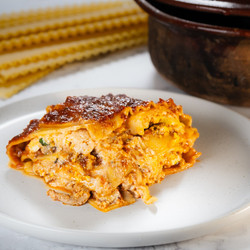In a large bowl, combine the ground pork, bread crumbs, Parmigiano cheese, ½ cup (50 g) pecorino cheese, egg, minced parsley, and a big pinch of salt and pepper. Mix thoroughly by hand. The meat should be soft and moldable but not too sticky. If it is, add some more fresh bread crumbs. Roll the mixture into 1-inch (2.5 cm) balls.
Fill a small pot with about 2 inches (5 cm) of frying oil and heat over medium/high heat. When the oil is hot, carefully drop the meatballs in a few at a time. Fry until browned and remove with a slotted spoon to a paper towel to drain. After frying all the meatballs in batches, let them cool and cut each of them in half. Set the meatballs aside for later.
Heat 2 tablespoons (30 g) of olive oil in a pan over medium heat. Prick the sausages with the tip of a knife in multiple places and add these into the pan. Turning frequently, cook the sausages until they are browned on all sides and cooked through. Let them cool, then cut them into sliced rounds and set aside for later.
In a mixing bowl, combine the ricotta with 1 cup (100 g) of pecorino cheese (or to taste), the basil, about 1 cup (240 ml) ragù, and a big pinch of salt and pepper. Mix thoroughly and set aside for later.
Bring a very large pot of water to a rolling boil and salt it generously. Add the lasagne pasta sheets into the water and boil for 2 to 3 minutes less than the recommended “al dente” cook time. You may need to boil the pasta in batches, depending on how big your pot is. Using tongs, transfer the cooked pasta into a large mixing bowl, drizzle it with plenty of olive oil, and toss it so that each sheet is coated in oil and won’t stick to the rest.
Preheat the oven to 415°F (215°C).
Spread a thin, even layer of ragù in the bottom of a 9x13-inch (23x33 cm) lasagna dish. Drape sheets of pasta over the long edges of the dish, so that the inward ends of the pasta reach the center of the dish bottom. Drape other sheets over the short edges of the dish as well. The result should be that the bottom of the lasagna is completely covered and all the edges of the dish have pasta draped over that can be folded in later (see pictured).
Spread a thick layer of ragù over the pasta base. Follow this by evenly spreading on top roughly a third of the halved meatballs, sliced sausages, chopped mozzarella, sliced hardboiled eggs, and ricotta. Finish the layer with a generous grating of Parmigiano-Reggiano cheese.
Top the fillings with a layer of pasta. Cut and trim the pasta sheets into smaller pieces as necessary to fill any gaps and create a complete layer. Next, repeat the step above to add more fillings, followed by one more pasta layer and a final layer of fillings. You should end up with the final pasta base, three layers of filling, and two inner layers of pasta in total.
Fold the overhanging pasta inward to completely cover the top of the lasagna. Spread a thick layer of ragù on top, followed by a generous grating of Parmigiano-Reggiano cheese. Loosely cover the lasagna with aluminum foil and bake for 30 minutes. Remove the foil and bake for a further 20 minutes, or until the top begins to crisp. If you’re having trouble getting the top to cook, you can always turn on the broiler for a few minutes at the end.
Let the lasagna rest for 10 to 15 minutes before serving.
